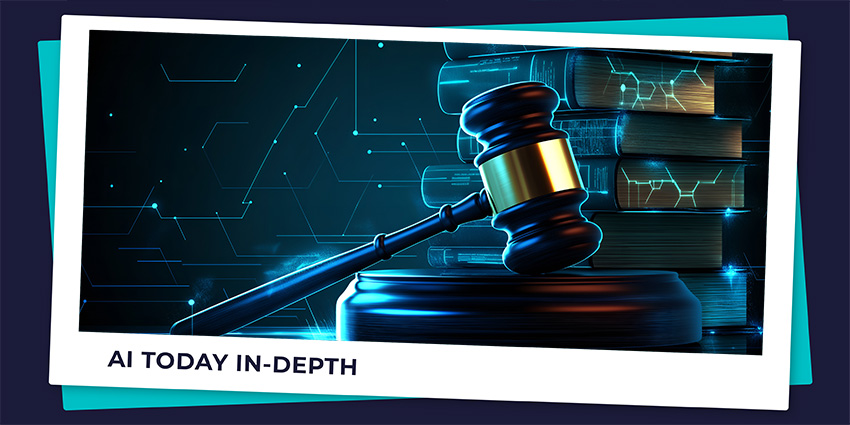Artificial intelligence governance is quickly emerging as a hot topic, for businesses, governments, regulatory bodies, and consumers alike. Every day, new innovations in the AI landscape emerge, driving increased adoption of intelligent technologies.
The rise of generative AI, in particular, has helped artificial intelligence surge into the mainstream. Virtually every company is using some form of AI today, to boost productivity, enhance creativity, or simply optimize customer service.
However, while the benefits of AI can be astronomical, there are endless risks to consider, too. The more we experiment with AI, the more we discover challenges to overcome that are linked to privacy, safety, and security. That’s where AI governance comes in.
By following careful frameworks for the creation, use, and management of artificial intelligence, business leaders can ensure they use AI ethically, responsibly, and compliant with changing regulations.
Here’s your complete guide to the evolving world of artificial intelligence governance.
What is Artificial Intelligence Governance?
Artificial Intelligence governance, or AI governance is the legal framework for ensuring AI and machine learning technologies are developed with the aim of helping humanity, minimizing risk, and ensuring tools are both ethical and safe. Governance strategies involve processes, standards, and guardrails that ensure AI research, development, and use occurs with a focus on safety.
Ultimately, governance initiatives aim to close the gap between ethics and accountability in technological advancements. Effective AI governance helps to determine how much of our lives intelligent algorithms and models should impact and in what way.
The concept is still evolving, but already regulatory leaders are introducing governance standards that address common risks like AI bias, privacy infringement, and misuse. In many ways, AI governance goes hand-in-hand with both responsible, and ethical AI standards.
While AI is a transformational technology, it’s far from perfect. Even the most advanced tools are designed by humans, and human-designed systems are susceptible to bias and errors.
Governance methodologies provide a structured approach to mitigating the risks of AI. It ensures that machine learning algorithms and AI models are monitored, evaluated, and regularly updated to prevent flawed or harmful outcomes.
Understanding Levels of Artificial Intelligence Governance
One thing to keep in mind is that AI governance doesn’t have the same standardized levels as cybersecurity, which might have defined levels of “threat response” strategies. Instead, AI governance relies on structured frameworks and approaches that can be adapted to an organization’s specific needs.
Organizations can use various frameworks and guidelines to develop their own governance practices, and the levels of governance implemented can vary depending on the AI systems, the company’s size, and the regulatory environment surrounding the firm. Approaches might include:
- Informal governance: Following simple, informal processes, such as reviewing AI systems focusing on ethics, or creating internal committees to oversee AI usage.
- Ad hoc governance: This involves the development of certain procedures and policies for AI development and use. Often, this type of governance responds to specific risks, challenges, and changes in the business and regulatory environment.
- Formal governance: A formal governance strategy involves the development of comprehensive frameworks that reflect an organization’s values, and the regulatory climate. These frameworks include risk assessments and oversight strategies.
Why is AI Governance Important?
As the use cases for AI continue to evolve, and adoption increases, artificial intelligence governance is becoming increasingly essential. On a broad scale, AI governance is the key to ensuring we can globally reach a future where trust, compliance, and efficiency is core to the development, and use of AI technologies.
Adopting AI governance isn’t just about adhering to emerging regulations and avoiding fines. It’s about creating a world where we can all trust in the safety of AI technologies.
We’ve already seen plenty of examples of the damage that AI can cause. Deepfakes created by generative AI have contributed to the spread of misinformation, and political turmoil. Companies using AI without robust security measures have suffered major data breaches, putting both their intellectual property, and customers at risk.
Even AI solutions like generative AI chatbots, developed without robust governance controls have led to the creation of dangerous, biased, and discriminatory tools. Some of these tools can be particularly dangerous to human beings. For instance, just look at the “COMPAS” algorithm which was found to make biased sentencing decisions in the legal space.
Regulatory bodies and governments recognize the social and ethical harm AI can cause without proper oversight. By providing guidelines and frameworks for keeping AI safe, governance will help to protect future users at scale.
AI governance even helps to ensure we can rely on the “decisions” that AI systems make to be fair, and accurate. This is crucial as companies use more AI tools to make decisions about how to serve customers, create products and more.
AI governance isn’t just about ensuring one-time compliance either. It’s about creating a framework for sustaining ethical and responsible AI standards over time, as models evolve.
Current Examples of Artificial Intelligence Governance
Although new AI governance standards are currently being developed, there are already regulatory guidelines in place that have an impact on AI usage. For instance, GDPR governs how personal data and privacy are protected by organizations. While it doesn’t focus exclusively on artificial intelligence, many of the provisions of GDPR are relevant for AI systems.
For instance, GDPR dictates how companies store, collect, and use customer data throughout the European Union. This influences how organizations can use this data to train and fine-tune bots.
Elsewhere, more specialized governance frameworks are starting to emerge. The Organization for Economic Co-Operation and Development created a set of “AI principles” adopted by more than 40 countries that prioritize transparency, accountability, and fairness in AI systems.
Some businesses have even begun to design their own committees for overseeing ethical AI and artificial intelligence governance. For instance, IBM has a dedicated ethics council, responsible for reviewing and monitoring AI products and services, to ensure ongoing compliance.
The Regulations Shaping AI Governance
The explosion of generative AI, and the rise of new innovators in the artificial intelligence space has begun to prompt the development of new regulations. These regulations are still in flux, and are likely to change continuously in the years ahead. Right now, some of the key frameworks include:
European Regulations for AI
The European Union’s “AI Act” was one of the first comprehensive regulatory systems for AI developed for the modern world. It governs the development or use of artificial intelligence throughout the European Union with a risk-based approach.
The AI Act actually prohibits some forms of AI use entirely, defining “harmful” uses of AI that could damage communities. Beyond this, the Act also requires all AI users (and developers) to implement strict risk management, transparency, and governance strategies.
The EU AI Act even introduces rules for general-purpose AI models, like Meta’s Llama 3 open-source model. Depending on the level of non-compliance, people who break those rules can face penalties of up to 7% of worldwide turnover.
Beyond the AI Act, Europe is also exploring other forms of regulatory frameworks. In 2021, for instance, the European Commission introduced an “AI package”. This included statements about potential strategies for implementing legal standards around AI. In particular, it notes that high-risk AI solutions should be subject to stricter requirements, and systems deemed to pose an “unacceptable risk” should be banned from the EU entirely.
Regulations in the USA and Canada
Various bills and executive orders govern artificial intelligence in the United States. One of the most recent examples is the “Executive Order” for the safe use of artificial intelligence introduced by President Biden in 2023. This order outlines numerous guidelines for ensuring that artificial intelligence is safe and secure and prioritizes “responsible innovation.”
Elsewhere, SR-11-7 is a regulatory model governance standard specifically designed to regulate AI in the banking and financial industries. This regulation requires bank officials to apply company-wide risk management initiatives to protect against damages caused by artificial intelligence. Leaders must also prove that the models they use are up-to-date, effective, and reliable.
Beyond this, the Federal Artificial Intelligence Risk Management Act was introduced in 2023, specifically focused on AI governance for federal agencies. Plus, there’s the Algorithmic Accountability Act of 2023 and the National AI Commission Act, which propose implementing strict guidelines for managing risk in AI systems.
Canada is exploring numerous solutions for artificial intelligence governance too. It was one of the first countries to adopt a national AI strategy in 2017. The country also has a specific directive on “Automated Decision Making” that describes how AI should guide decisions and actions across numerous industries and departments.
Plus, Canada’s Artificial Intelligence and Data Act (if implemented), will regulate AI at the federal level, determining how AI solutions are designed, developed, and used throughout the country. It would also prohibit certain uses of AI, similar to the EU Act, and the US Executive Order.
Regulations in the Asia-Pacific Region
Just like in the US and UK, regulations in the Asia-Pacific region are still evolving. Many companies in the region are adopting guidelines similar to those introduced by the EU AI Act, and US governance standards.
In 2023, China introduced Interim Measures for generative artificial intelligence solutions. These measures suggest that AI solutions should always respect the legitimate interests and rights of others. There’s also a provision for ensuring that AI doesn’t harm the mental or physical health of others, or infringe on rights related to reputation, honor, privacy, personal information, or portrait rights.
Many other countries throughout the APAC region have released principles and guidelines for governing AI, too. Japan is in the early stages of preparing its AI law, which is focused on promoting responsible AI.
India is working on new AI regulations, alongside Maylasia, South Korea, and Thailand. Singapore’s federal government has also released a framework with guidelines addressing AI ethics and safety in the private sector. The country also released a governance framework for generative AI in 2024.
The Elements of an Artificial Intelligence Governance Framework
As mentioned above, there’s currently no one-size-fits-all way to approach artificial intelligence governance. Companies can create their own policies, providing they’re adhering to the rules emerging in their jurisdictions. For the most part, an AI governance framework will depend on the organization’s specific values, and the wider demands imposed by new regulations.
For instance, most regulatory guidelines surrounding AI governance focus on factors like:
- Explainability: Designing AI systems in a way that ensures people can understand how and why they make certain decisions.
- Accountability: Accountability in AI ensures that there’s a clear insight into who is responsible for the actions taken by AI systems.
- Safety: AI systems need to be deployed, designed, and managed in a way that protects the safety and wellbeing of all users, and preserves human rights.
- Security: Security is essential to protecting AI systems from breaches, unauthorized access, and potential misuse. Solutions should be infused with systems that safeguard confidentiality, data, and the overall AI application.
- Transparency: There needs to be clarity and openness in determining how AI algorithms operate, make decisions, and process logic.
- Fairness: Businesses should design and use AI systems in a way that avoids bias, and ensures ethical, just, and impartial decisions.
- Reproducibility: This concept refers to the ability to recreate the results produced by AI systems under the same conditions, ensuring consistency in results.
- Robustness: A focus on robustness looks at developing AI systems and frameworks that can withstand manipulation and tampering attempts.
How Companies are Implementing AI Governance
Although various firms are taking different approaches to artificial intelligence governance, most businesses today need to implement at least some kind of strategy. We all know that AI delivers incredible benefits to the enterprise, from enhancing efficiency to reducing costs.
However, implementing AI solutions without focusing on governance puts companies at risk of fines, reputational damage, and severe security issues.
Most of the strategies companies rely on today involve using cutting-edge technology and monitoring tools to track the end-to-end performance of AI systems. Leading innovators in the AI landscape can provide access to visual dashboards that deliver real-time updates on the health and status of AI technologies.
These solutions can provide companies with access to “health metrics” identifying a system’s overall performance and custom metrics related to a firm’s unique KPIs. With end-to-end monitoring solutions, companies can even automate the detection of bias, drift, and performance anomalies in AI technologies.
What’s more, in-depth reporting and analytics resources allow companies to invest in transparency and accountability in AI tools. They enable the creation of audit trails and insights into AI decision-making processes.
The Evolving Challenges of AI Governance
As risks around AI continue to evolve, implementing comprehensive governance standards will become increasingly complex. However, that doesn’t make this process any less important. Ensuring AI governance doesn’t rest with a single department or CEO. It’s a collective responsibility that requires end-to-end collaboration.
Since direct guidelines for AI governance are limited, most companies will rely on self-governance strategies for now. According to experts like the World Economic Forum, self-governance will require a combination of organizational, and automated technical controls to be implemented into AI strategies.
Businesses will need to carefully consider the voluntary frameworks they follow with governance strategies, accessing tools like NIST’s Risk Management Framework or the UK AI Safety Institute’s “Inspect” AI safety evaluation platform.
However, at the same time, implementing automated solutions to monitor the performance of AI solutions at scale will become increasingly important. This is particularly true as the use of AI continues to increase across organizations.
Moreover, the World Economic Forum notes that to ensure artificial intelligence governance standards thrive in the years ahead, there will be a greater need for specialists with expertise in AI technologies. Businesses will need AI professionals who understand the latest regulations and can implement organizational and technical controls at scale.
These professionals will need to be regularly trained and upskilled, to respond to new standards and risks as they emerge. Fortunately, training solutions are already appearing, such as the Artificial Intelligence Governance Professional certification.
The Future of Artificial Intelligence Governance
Artificial intelligence is transforming how people live and work on an unprecedented level. The rapid adoption of AI technologies does have benefits for humanity. AI tools are making us more productive, efficient, and creative than ever before. But there are risks to consider, too.
To ensure artificial intelligence positively impacts the world, we need a worldwide collaborative approach to refining AI governance. Everyone involved with AI, from developers creating new systems, to companies implementing AI into their workflows, will need to work together to keep this technology safe.
The good news is that if we can join forces on a holistic approach to AI governance, the risks of working with intelligent solutions will diminish. We’ll be able to ensure we can unlock the full value of this technology without exposing ourselves to unnecessary threats.








